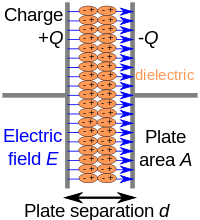
Photo from wikipedia
Abstract Structural characteristics exert significant influences on microwave dielectric properties, and ion substitution is widely adopted to modify material performances by adjusting the crystal structure. In this work, low loss… Click to show full abstract
Abstract Structural characteristics exert significant influences on microwave dielectric properties, and ion substitution is widely adopted to modify material performances by adjusting the crystal structure. In this work, low loss Li3Mg2-xCuxNbO6 (x = 0–0.04) ceramics were prepared by Cu2+ substitution. The impacts of Cu2+ substitution for Mg2+ sites on the microwave dielectric characteristics and crystal structure were discussed in detail. Rietveld refinement results implied that a single Li3Mg2NbO6 phase was formed. Additionally, a dense and homogeneous microstructure with grain sizes of 7–9 μm could be achieved, and moderate Cu2+ substitution could significantly promote the grain growth. The correlation between microwave dielectric characteristics and crystal structure was discussed by calculating some structural parameters. The er was determined by the polarizability. The Q × f was influenced by the packing fraction. The τf value was dependent on the NbO6 octahedron distortion, and the τf value could be adjusted to near zero for x = 0.02. Typically, the Li3Mg2-xCuxNbO6 (x = 0.02) composition exhibited remarkable microwave dielectric performances: er = 15.75, Q × f = 92,134 GHz (9.86 GHz) and τf = −2 ppm/°C, making it a promising candidate for temperature-stable millimeter-wave applications.
Journal Title: Ceramics International
Year Published: 2019
Link to full text (if available)
Share on Social Media: Sign Up to like & get
recommendations!